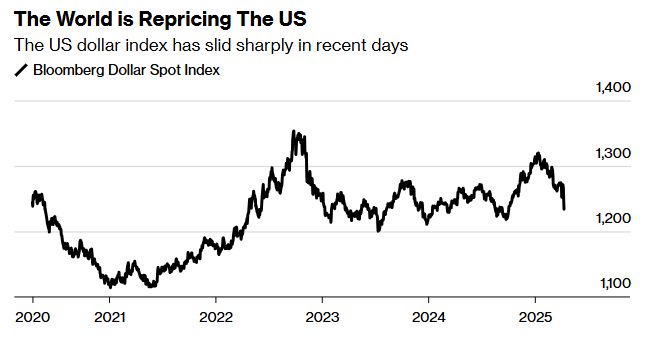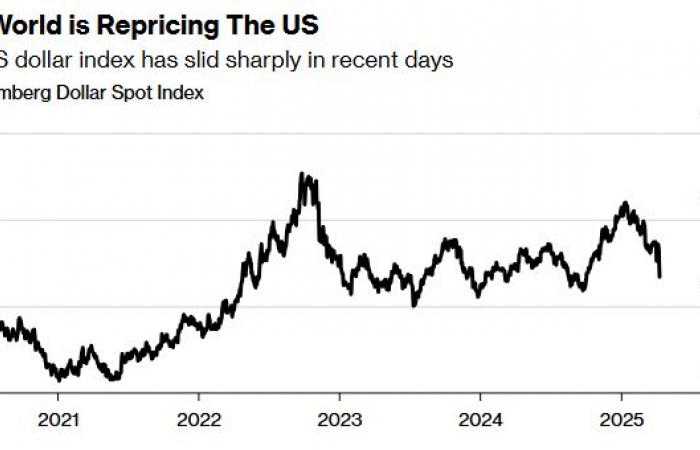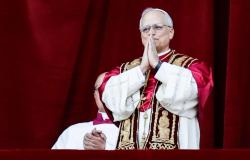The US dollar has been the anchor of the global financial system for decades. But in recent weeks, market behavior has started telling a different story.
While President Donald Trump continues to redouble efforts in customs taxes and political threats, capital is starting to go elsewhere.
What was formerly considered a refuge currency is now perceived as a problem. While investors lose confidence in the dollar, the euro evolves in the opposite direction.
We generally see this only until war or financial crisis. But today, serious discussions emerge as to the realistic possibility of replacing the US dollar as a global reserve currency.
What has just happened with the US dollar?
Copy link to sectionFriday, April 11, the US dollar reached its lowest level in three years against a basket of major currencies.
It has dropped almost 10 % since the start of the year. The euro has won 9 % since the end of February, reaching $ 1.14. Traders qualify this movement of one of the most sudden on the foreign exchange markets since 2008.

The stock market has not resisted better. The tendency to “sell America” has grown in recent weeks. Nearly $ 5,000 billion was erased from the valuations of American actions during this period.
The bond market, usually a safe refuge during periods of volatility, no longer behaves as such.
The yield of US Treasury bills at 30 years old jumped from 4.4 % to 4.8 % in a single week, the highest increase in 1982.
It is not a normal market correction. It is a rare moment when American actions and treasury bills fall simultaneously.
This generally only happens when investors are starting to lose confidence in the system itself.
Why is this massive sale different from the previous ones?
Copy link to sectionThe trigger was the so-called measures on the customs taxes of Trump’s “Liberation Day”. But the reaction has largely exceeded short -term concerns.
What is currently happening is a broader reassessment of the role of the dollar in the world economy. Others describe it as a “dedollarization”.
US debt purchases by foreigners have become negative in January for the second time in four years.
Central banks are starting to diversify their assets. Investors turn to the euro, yen, gold and Swiss franc. Even Canada and Australia have a slight increase in demand for their currencies.
Christine Lagarde, president of the European Central Bank, said this week that Europe should be ready for anything, including scenarios where access to the dollar is restricted or confidence in American commitments would weaken.
His message to European leaders was without detour: stop waiting.
Trump, did he accelerate the decline?
Copy link to sectionYes. What we used to call the “exorbitant privilege” of the United States, that is to say the ability to borrow cheap because the world wants your currency, now begins to look more like a passive.
Trump’s trade war has targeted both allies and adversaries. He hinted that he could be lacking on part of the national debt of $ 34,000 billion.
Some advisers would apparently like to convert short -term treasure bills into bonds at 100 years, with additional taxes for foreign holders. Others openly speak of a modern version of the Plaza agreement to devalue the dollar by force.
It is a policy of the economic rope. And the markets react accordingly.
Mark Sobel, former head of the American Treasury, says that if there is no viable alternative to the dollar today, Trump undermines the institutional foundations that have allowed his domination.
-The world no longer presumes that the United States will act responsible for crisis. It’s new.
Can the euro fill the ditch?
Copy link to sectionFor another currency to dethrone the dollar, some conditions must be met, at least in theory. One of the most important examples is to operate as the main global exchange reserve currency.
Currently, the euro represents approximately 20 % of world exchange reserves. This figure has hardly evolved in a decade. The US dollar still represents almost 60 %.
At the same time, there is a significant difference between European and American bond markets. The US Treasury Treasury Market represents $ 28.6 Billions.
The total outstanding of the public debt of the euro zone is around 13,000 billion euros, and only 4,000 billion euros meet the safety criteria of central banks.
In addition, there is no unified Euro-conductor market. Transfering banking operations within the EU remain ineffective. And in times of crisis, it is still the Fed which provides global liquidity through swap lines.
However, there could still be hope for Europe. The recent strength of the euro was supported by a realignment of European policy.
Germany softens its budgetary rules. The EU plans to spend more than 800 billion euros for the defense by 2030. This would give a feeling of legitimacy to the Euro.
If it was implemented, this measure would create more assets denominated in euros that the world could hold. It would also deepen the capital markets in the euro zone, which have always been too fragmented to compete with American treasury bills.
So, even if the euro progresses, it is not ready to take over. At least not yet.
What is the plan for the euro?
Copy link to sectionThe dollar is not going to disappear from the global system. He still underlies the energy trade, the world debt markets and the reserves of central banks.
But he is no longer alone. We head for a more fragmented and multipolar financial order.
The euro is the most likely challenger, but it needs political support and a coherent strategy.
Several leading economists have exposed what Europe should do. The expansion of the stock of secure assets denominated in euros is an essential first step.
Then, the EU must set up swaps networks in euros which reproduce emergency loans from Fed to foreign banks, and encourage greater billing of exchanges in euros, especially in the Green Energies and Critical Minerals sector.
Lagarde echoes this vision, saying that the euro can become the currency of the green transition.
It is not only a brand image. It is a question of creating a new value base, as did oil did for the dollar. Already, most green obligations in the world are labeled in euros.
If Europe can charge a larger share of world -wing technologies and infrastructure in euros, its role could grow naturally. Perhaps not to the point of exceeding the dollar, but by reducing the excessive dependence of the world towards it.
A probable scénario
Copy link to sectionYes, the US dollar slowly loses the conditions that support its reserve currency status. And no, no other currency is still ready to replace it.
What we observe is not a brutal collapse, but a progressive transition to a system of multipolar reserves.
It is a system where the euro gains ground in European trade and green finance.
The renminbi continues to extend its influence through the savings of the belt and the road. Finally, the Yen, the Swiss franc, the Canadian dollar and the Australian dollar serve their respective regions and functions within the system.









